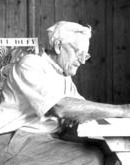

Rudolf Olgiati
*9. 9. 1910 – Chur, Switzerland
†25. 9. 1995 – Flims, Switzerland
Biography
Architect Rudolf Olgiati developed in the mid-20th century a synthesis between the anonymous building tradition of classical Greek architecture and modernity, which was oriented towards the ideas and works of Le Corbusier. The knowledge he gained then served as the basis for his thesis that there is a timeless natural sense for aesthetic connections: “Beauty is a value for our soul. And architecture is responsible for that.”Rudolf Olgiati created substantial cubist architecture. He primarily built family homes, often temporary residences in the mountainous canton of Graubünden, mainly in Flims and its surroundings. He also restored historically valuable rural and urban houses. In his architecture, he combined old building elements with new features and uncompromisingly translated traditional forms (such as the funnel-shaped window, arched vault, sculptural gargoyles, and tower-like chimneys) into contemporary language. His buildings were the result of a diligent search for meaning and reason brought into harmony.
The English translation is powered by AI tool. Switch to Czech to view the original text source.
Realizations and Projects
House Dr. Wolff, Hagen, 1990-93 Family House, Walenstadt, 1988
House Palmy, Laax, 1980
House Schorta, Tamins, 1975
House for the architect's brother, Flims, 1964
Residential Building Las Caglias, Flims-Waldhaus, 1960
House Coray, Flims-Waldhaus, 1958
Residential House, Unterwasser
House Domeniconi, Flims







